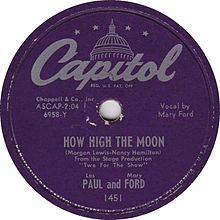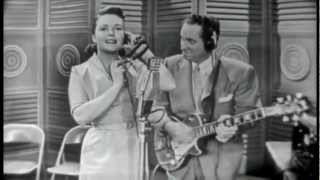“How High the Moon” by Les Paul & Mary Ford is a classic pop song.
Summary quotation from Wikipedia:
“How High the Moon” is a jazz standard with lyrics by Nancy Hamilton and music by Morgan Lewis. It was first featured in the 1940 Broadway revue Two for the Show, where it was sung by Alfred Drake and Frances Comstock.
In Two for the Show, this was a rare serious moment in an otherwise humorous revue.
Most notable recordings
The earliest recorded hit version was by Benny Goodman & His Orchestra. It was recorded on February 7, 1940, and released by Columbia Records as catalog number 35391, with the flip side “Fable of the Rose”. The Les Paul Trio recorded a version released as V-Disc 540B with a spoken introduction which was issued in November, 1945 by the U.S. War Department. In 1948, bandleader Stan Kenton enjoyed some success with his version of the tune. The recording, with a vocal by June Christy, was released by Capitol Records as catalog number 911 (with the flip side “Willow, Weep for Me”) and 15117(with the flip side “Interlude”). It reached the Billboard magazine Best Seller chart on July 9, 1948, its only week on the chart, at #27.
The best-known recording of the song is by Les Paul and Mary Ford, made on January 4, 1951. The record was released by Capitol Records as catalog number 1451, with the flip side “Walkin’ and Whistlin’ Blues”, and spent 25 weeks (beginning on March 23, 1951) on the Billboard chart, 9 weeks at #1. The record was subsequently re-released by Capitol as catalog number 1675, with “Josephine” on the B-side.
The song has become a gypsy jazz standard and has been recorded by several musicians of the genre.
Trivia
Paul McCartney stated during the filming of Les Paul: Chasing Sound that “How High the Moon” was the first song The Beatles played when they first got together.
Recording
Quotations of Les Paul from Sound On Sound:
“I knew from the beginning that there was a great marriage between electronics and music,” Les Paul explained. “I’d play my guitar and my mother or my brother would tell me how good it sounded, but I wanted to hear it, and the only way that could happen was if I could hear it played back. So I built a crank phonograph and turned it into a recording device like Edison had — without even knowing who Edison was. The electronics were all in my living room. In addition to the phonograph I had a player piano, a telephone and a radio. I took the telephone apart at the receiver end, and when I looked at it I figured that the two coils were humbucking and quickly understood what the receiver was doing. Then I looked at the mouthpiece and worked out what that was doing. It was all right there in the living room. I never had to leave it — and I didn’t!
“I built two disc machines, and I’d bop between them while I played the first part and then added the second, third, fourth, fifth parts and so on. However, that was a rather difficult way of doing things, and the sound on sound also became a little tricky because of the degeneration that took place. After you’d go 25, 30 dubs down, that first part got to sound pretty bad. So, what we did was layer the parts down in the order that would best cope with the sound deterioration. Instead of putting the first part on first, we might put it on last — it was all about the importance of the part we were dealing with. If I was beating out a drum part, a rhythm, with my hands on the guitar, that could deteriorate all it wanted and it didn’t matter, and the same applied if I was just laying down some organ chords with tremolo on them.
“The important thing was the first part of a vocal or the first part of a guitar solo, so we’d plan things out and what went down would not be in a logical order like it would today when you lay down the rhythm tracks, the melody, the harmony. We didn’t do it that way at all. And that was one of the key secrets as to why the balances came out right. When you listen to those old recordings you might say, ‘My goodness, how in the world did they know how loud to make the bass and how loud to make the second part or the third part? How could they get everything that exact?’ Well, that was because we’d lay down the least important parts first and then work our way through the recording until the parts that we’d want to hear the clearest and cleanest went on last. It was a very unusual way of recording, but that’s what we had to do.
“What made me particularly proud of those wax machines was that they were made with Cadillac flywheels. My dad had a garage, and one day I was there, asking for something 16 inches in diameter that was balanced and would hold a round disc. The mechanic came out from underneath a car and he said, ‘You know what’s dynamically balanced and would fit the bill? A flywheel. There are a couple of cars out in the alley — why don’t you do a hysterectomy on one of them?’ So, we did. We took the flywheel out of a Cadillac, and the other part we needed came from my drummer who was a dentist. One time, he was cleaning my teeth and I saw all these dental belts, so I asked where he got them and I ordered some because they were endless belts and they were perfect for isolating the flywheel, the turntable and the recording device from any vibrations in the motor or even from trucks driving by outside.”
In 1946 Les Paul saw a tape machine, an AEG Magnetophon using plastic-based magnetic tapes invented by the Germans and rescued by a group of US Army officers in Luxembourg.
“Judy Garland and I flew from LA to New York to do the Paul Whiteman Show,” Les Paul stated, “and at the rehearsal this fellow kept trying to get my attention. Finally, I walked over to him and he told me that his name was Colonel Dick Ranger and that he had a tape machine that Sherman Fairchild — the founder of Fairchild Aviation, Fairchild Camera and Instrument, and Fairchild Recording — thought I should see. Well, Judy and I got into a car with Colonel Ranger and went to see this device, and then I called Bing Crosby out on the coast and told him about it. It turned out that one of the fellas working for him, Jack Mullins, had been in the same signal corps as Colonel Ranger, and he also had a tape machine, but he’d left it in pieces in his garage. So he dug out the pieces and took them to Ampex, and Ampex bought them right there on the spot. Colonel Ranger already had the assembled machine but he was not a good businessman, so it was Jack Mullins who made the very first tape machine for Ampex, which was the 200. The rest is history.
“In 1949, Bing Crosby brought an Ampex 300 over to my house in LA, where I was then living. He asked me to go out into the front yard and help him get it out of his trunk, and then once I did that and the machine was indoors he said, ‘Well, have fun,’ and left. So, there I was, busy recording to disc, and I looked at the machine and all of a sudden the light went on — what if I put a fourth head on this machine? I took a piece of paper and a pencil, I drew it out, and I went to Mary and I said, ‘Forget hanging up the laundry, forget the whole thing. Lock the place up, we’re leaving. I’ve just found a way to record without needing the garage or a recording studio. I can do the whole thing anywhere that we wish to record.’ All I needed was a fourth head on that mono 300 deck.
“Oh yes, I knew it would work, but Mary didn’t. We drove from LA to open up in Chicago at the Blue Note, the machine was in the truck of our car, and when we got to New Mexico she said, ‘What if it won’t work? You haven’t tried it yet.’ I said, ‘Oh, it’ll work,’ but as we kept driving she’d say, ‘Well, you didn’t make a prototype. This thing may not work.’ The closer we got to Chicago, the more concerned I became about the fact that I hadn’t made a prototype. Without that I couldn’t be absolutely positive it would work. However, I’d called Ampex before we left California and told them I needed another head that they should send to Chicago, and when we arrived in Chicago and went to the New Lawrence Hotel the head was waiting for me. So, I got a guy to drill a hole in the machine for me and we mounted the fourth head, and then I turned the machine on, Mary said, ‘One, two, three, four, testing,’ and I said, ‘Howdy, howdy, howdy,’ and my God it came back.
“At that time I was still walking with crutches following our automobile accident, and I threw my crutches in the air and we danced around in the hallway. Then we got in the elevator and went to work, and that was a big day. After that we’d record ‘How High the Moon’, ‘The World is Waiting for the Sunrise’… in fact, at least 90 percent of our recordings were made on that [Ampex 300] device, not on the eight-track.”
Multi-Grammy-winning engineer Bruce Swedien said, “The first time I really got excited about pop music was when I discovered that it was possible to use my imagination. That had come with a record that I myself didn’t work on, Les Paul and Mary Ford’s ‘How High the Moon’, in 1951. Up to that point the goal of music recording had been to capture an unaltered acoustic event, reproducing the music of big bands as if you were in the best seat in the house. It left no room for imagination, but when I heard ‘How High the Moon’, which did not have one natural sound in it, I thought, ‘Damn, there’s hope!’“
“How High the Moon” was recorded in Les Paul’s home studio in Jackson Heights, New York City, using an Ampex 300, a power supply unit, a small home-grade mixer, a Bell & Howe amplifier, a Lansing Manfacturing Iconic speaker, and a single RCA 44BX ribbon micorphone.
“We had to fold the Murphy bed into the wall in order to put the machinery in there,” according to Les Paul. “My buddy Wally Jones built the mixer. This had a channel for Mary to sing on and one for me to play the guitar, and there was no VU meter. With anything that we recorded there was never a VU meter and there were also no equalisers. I was flying absolutely blind. I went by my ear, wearing a pair of Armed Forces headphones that I think were in the range of 5Hz to 50kHz, and I’d just bring the level down a little bit if there was any distortion.
“One of the things that intrigued the guys at Capitol was how the needle always looked like it was standing still. One day, the president of the company stopped me and said, ‘Hey, we’ve finally figured out what to do. We’ve built a limiter-compressor, and with this we now are able to do what you do.’
“In my case, I was so used to playing that, even without a meter, if I was going to hit a note I’d know that by hitting it here on the string it wouldn’t record as loud as if I hit it there. And it was the same with Mary’s vocals. She’d got to the point where no one had to tell her to back up on this note, move forward on that one, move sideways, or watch out for sibilance. We’d been doing it a long time and we were professionals.
“I had only one machine and, by the time we finished, the spliced tapes might be 6dB off and of a different bias. So, I’d press the record button and at that point the tape would go through and I’d be riding the gain to make everything the right level.
“After we discovered that the sound on sound was working, that night we went to work at the Blue Note. And after a couple of weeks there, I told Mary, ‘There’s something bothering me. If you listen when we play ‘How High the Moon’ on Monday, the crowd just goes crazy. Tuesday is almost as good as Monday, but by Wednesday we’ve got a problem. By Thursday and Friday it’s worse, and by Saturday it’s almost forget it. Then Sunday is pretty good, and again Monday is a great one. The reaction should be the same no matter what night it is, so we’re playing ‘How High the Moon’ wrong. We’re playing it for professional people who are off on Monday; bartenders, maitre d’s, musicians, and they want to hear it the way we play it. But on Wednesday, Thursday, Friday and Saturday we’ve got people who want to get away from the kids; blue-collar guys who are far removed from musicians and professionals.’
“So, when we next moved on to places like Rockford, Illinois, and Omaha, Nebraska, we kept trying ‘How High the Moon’ each night in three different ways until I was pretty sure that I’d found the arrangement that went down great every night of the week.
“It was very unusual to do this, but when the guys over at Capitol asked, ‘What in the world makes you think that this record is going to make it?’ I said, ‘Because I’ve put it to the test and my jury says this is the way it should be.’ And after we made it, the jury bought it right away. This was what we did with all our hit records — I would make sure that there was a jury of people who could tell me if something was good or not. However, I never told them they were part of a jury or that I’d like their opinions. I’d just watch their reactions.
“We were located right across from a firehouse and our first attempt was ruined when the siren went off. Then some planes came overhead on their way to La Guardia Airport and ruined the second one. At that point Mary began crying and saying, ‘I don’t know if I can do it again,’ and just when she decided she could, the guy who lived above us went to the bathroom. He must have weighed about 400 pounds, so we had to wait and wait while he took a leak and went to bed before we could go for it. You see, we’d record at night, and that kept the people upstairs awake. Mary would put a blanket over herself to isolate the sound — the guitar wasn’t a problem since it went straight into the earphones — but in this case those folks complained because they could hear her singing the fourth part, which had a lot of high and strange stuff. Still, in the end we got it done.
“The first thing that was recorded was me just rapping on the guitar. I turned the volume up and hit the strings, no chords — that was the rhythm and it set the tempo. Then the second thing that went down was just chords. This went on and on and on as I built it up, part after part, take after take. The lead vocal and my guitar went on second to last, and the last thing that went on was the bass, played on the last string on my guitar. Everything was done on that guitar — I never left it from the beginning to the end except to lay down under the tape machine and change motors or change capstans. It felt like I was under that machine much more than I was on top.”
—from Wikipedia (the Wikipedia:Text of Creative Commons Attribution-ShareAlike 3.0 Unported License applies to Wikipedia’s block of text and possible accompanying picture, along with any alterations, transformations, and/or building upon Wikipedia’s original text that ThisSideofSanity.com applied to this block of text)














